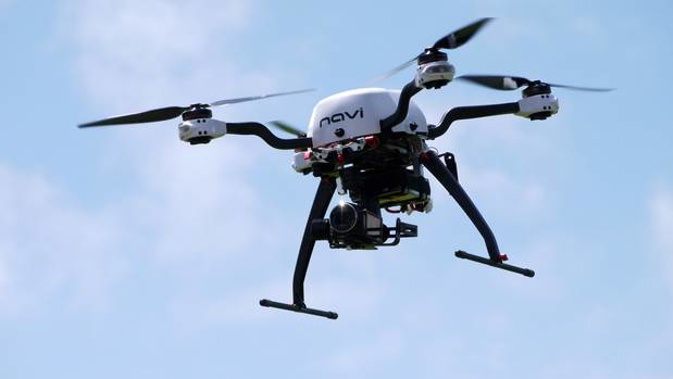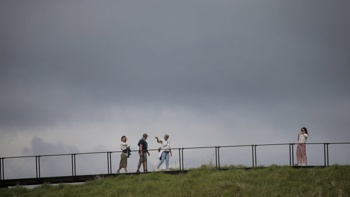
Drones caused 10 "near collisions" with aircraft in 2018 as the number of near-misses in our skies grows.
On Tuesday morning, Auckland's Police Eagle helicopter was grounded by what police describe as a "very near miss" with a drone, which flew within 10m of the chopper while it was over the motorway system.
Police said the flight crew had to take "immediate evasive action" and those on board were left "shaken", with Inspector Jim Wilson, acting District Commander Auckland City, saying it "could have easily ended in a tragedy".
The near miss comes as Air New Zealand and professional drone operators renew calls for tighter regulations to avoid disaster in our skies.
The unmanned aircraft have caused numerous airport delays, closed sections of airfields, and one also came within metres of hitting a Defence Force helicopter last year.
Information released by the Civil Aviation Authority (CAA) to the Herald on Sunday under the Official Information Act shows the 10 near-crashes in 2018 were the highest in three years.
The highest number of close calls was in 2015 when there were 11 near-crashes with an aircraft.
The new figures bring the total of near collisions, between 2014 and 2018, to 36 and drones flying in proximity to 90.
"Proximity" referred to when a drone was close enough to an aircraft that it could compromise a flight's safety.
There have also been at least six incidents, between 2014 and 2018, where air traffic controllers (ATC) have closed areas of an airfield due to drone sightings.
In December there was a spate of illegal drone incidents in Queenstown – including one passing in front of a passenger jet – that sparked three separate investigations by the CAA.
Airways air traffic services general manager Tim Boyle slammed the incidents, saying they're continuing to see a "worrying number of drones operating illegally in airspace near airports throughout New Zealand".
In April, operations at Auckland's Whenuapai Air Force Base were temporarily suspended after a near-miss between a drone and an Air Force helicopter.
A Defence Force spokesman said the incident happened just before 11am, when the helicopter approaching Whenuapai reported seeing a drone just 60m away from it.
Separate close calls were also recorded at Auckland Airport in March and April.
A drone came within metres of a flight descending into Auckland Airport from Tokyo in March, putting the safety of 278 passengers and crew at risk.
The airline said the drone passed so close that the crew worried it had been sucked into an engine, although a later inspection showed that had not happened.
Seven flights at Auckland Airport had their landings delayed in April due to a drone sighting.
And in August five flights were delayed after a drone was spotted near Auckland Airport.
An Airways spokeswoman said the pilot of a Dash 8 aeroplane spotted a drone flying at 700m about 12km from the airport over the Ormiston area.
Air New Zealand called for tighter regulations regarding drone use after the close calls.
When approached for comment Air New Zealand pointed the Herald on Sunday to a press release it issued in March, with chief operations and integrity standards officer Captain David Morgan saying that serious drone incidents were on the rise and policy makers "need to protect the travelling public with greater education, tighter regulation and stronger penalties for irresponsible operators".
Under current regulations, drone operators who breach aviation rules can be fined up to $5000.
Auckland Airport proposed early this year that a drone detection radar be positioned at the end of Auckland Airport's runway to prevent near-misses between planes and unmanned aircrafts.
The radar could potentially spot drones up to 9km away and 1700ft (518m) in the air.
Professional drone operator Philip Solaris, chief executive of X-Craft, said he had been aware of the rise in dangerous drone activity which was mostly due to recreational users.
As many as 250,000 drones were operating in New Zealand last year.
The main issue was recreational users, including children and also tourists who brought their aircraft to the country without learning rules of operation, Solaris said.
"CAA has a very good service for professional operators. I would dare to say it is more robust than for manned aircraft."
Solaris was working with Airways to develop a drone air traffic management programme that ties in with the air traffic system currently used by traffic controllers.
The power was not in the hands of Airways or CAA but politicians who needed to listen to the case studies and advice provided by the governing bodies, Solaris said.
"This will become an issue around regulation and the liberty to do what you want.
"There needs to be practical measures in place. We are talking about a serious thing here."
He wanted to see all drones required to have a device that told air controllers where drones are and for operators to pass a test of proficiency, as well as an age limit for use of the aircraft.
Meanwhile, police in England are still investigating a series of drone sightings near Gatwick Airport which caused the UK's second busiest airport to be closed down in the lead-up to Christmas.
Police are no closer to finding who was behind the incident despite a $94,000 reward posted by Crimestoppers.
Take your Radio, Podcasts and Music with you









